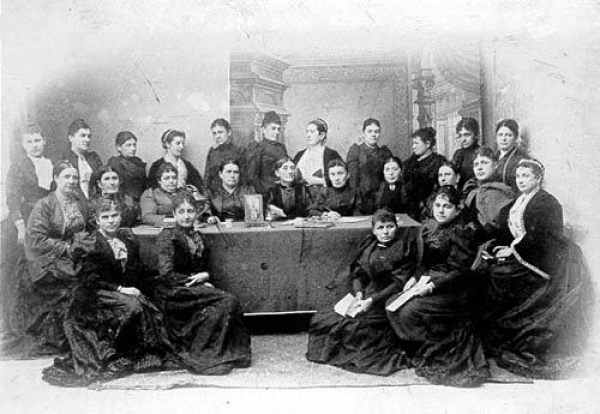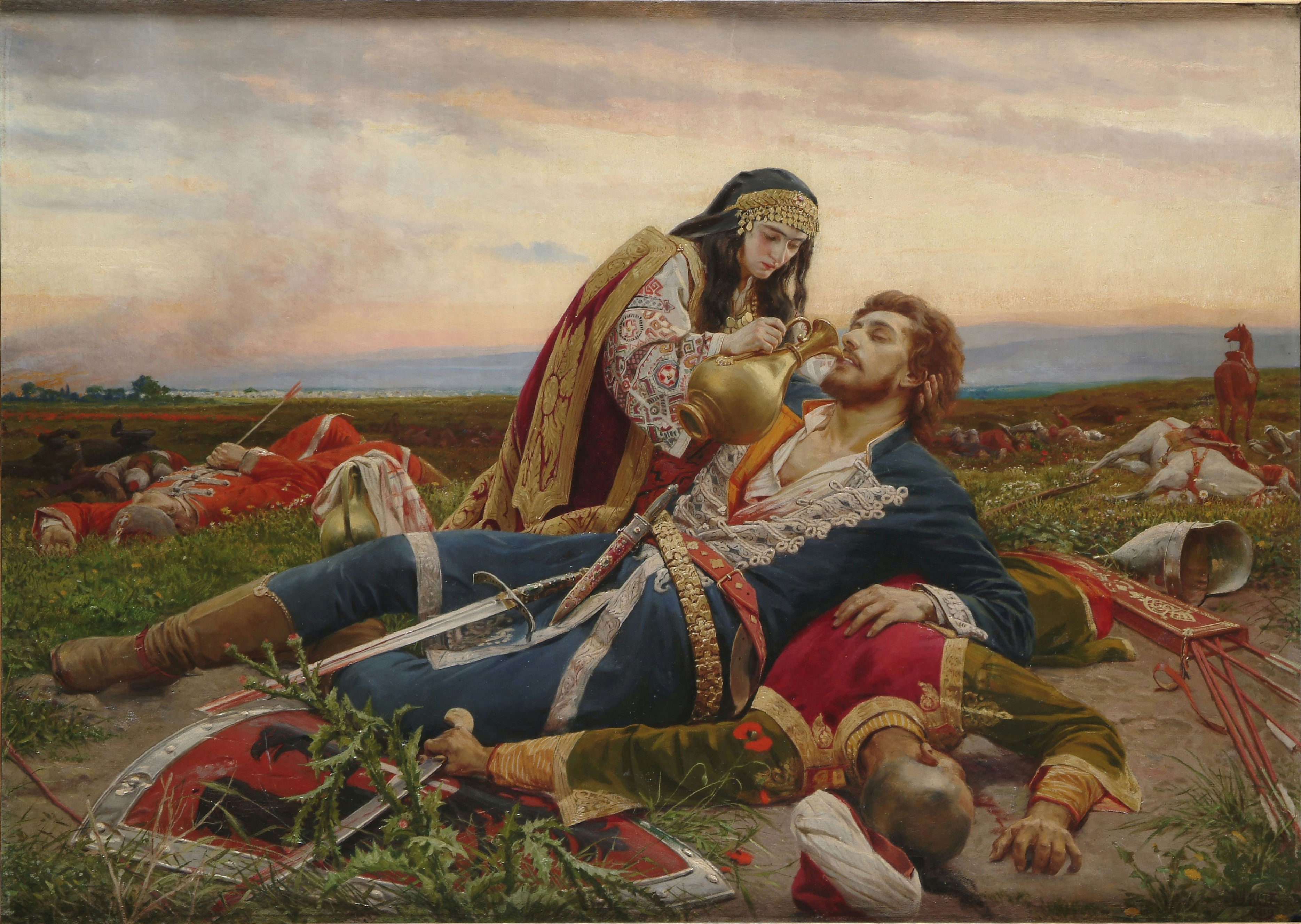|
Circle Of Serbian Sisters
The Circle of Serbian Sisters ( sr-Latn, Kolo Srpskih Sestara) was a women's charitable society established in Belgrade in 1903. Among the founders of the society were Mabel Grujić, wife of Slavko J. Grujić, Blanš Vesnić, wife of Milenko Vesnić, and after the May coup in Serbia (1903), the society was led by Nadežda Petrović, Delfa Ivanić, Draga Ljočić, Andjelija Stančić, Branislav Nušić and Ivan Ivanić. Regional organisations of the Circle of Serbian Sisters have been established in many areas where Serbs live. After the restoration of the Circle in 1990, the regional organisation Circle operates within the diocese of the Serbian Orthodox Church. History Its establishment was first proposed by Ivan Ivanić and Branislav Nušić. However, the organizers were Nadežda Petrović, famous expressionist painter, Delfa Ivanić, a teacher, and Savka Subotić, activist (wife of Jovan Subotić). Its first president was Savka Subotić, who resigned in 1905. Ljubica ... [...More Info...] [...Related Items...] OR: [Wikipedia] [Google] [Baidu] |
Vračar
Vračar ( sr-Cyrl, Врачар, ) is an affluent urban area and municipality of the city of Belgrade known as the location of many embassies and museums. According to the 2011 census results, the municipality has a population of 56,333 inhabitants. With an area of only 291 hectares, it is the smallest of all Belgrade's (and Serbian) municipalities, but also the most densely populated. Vračar is one of the three municipalities that constitute the very center area of Belgrade, together with Savski Venac and Stari Grad. It is an affluent municipality, having one of the most expensive real estate prices within Belgrade, and has the highest proportion of university educated inhabitants compared to all other Serbian municipalities. One of the most famous landmarks in Belgrade, the Saint Sava Temple is located in Vračar. Vračar borders five other Belgrade municipalities: Voždovac to the south, Zvezdara to the east, Palilula to the northeast, Stari Grad to the north and Savski Vena ... [...More Info...] [...Related Items...] OR: [Wikipedia] [Google] [Baidu] |
Women's Antifascist Front Of Yugoslavia
The Women's Antifascist Front ( sh, Antifašistička fronta žena, Антифашистички фронт жена, abbreviated AFŽ/AФЖ; sl, Protifašistična fronta žensk; mk, Антифашистички фронт на жените), was a Yugoslav feminist and anti-fascist mass organisation. The predecessor to several feminist front groups in the former Yugoslavia, and present-day organisations in the region, the AFŽ was heavily involved in organising and participating in the Partisans, the communist and multi-ethnic resistance to Nazi occupation of Yugoslavia during World War II. It was formed by volunteers on 6 December 1942 in Bosanski Petrovac at the First National Conference of Women. Name In its early days, the organization was called ''Antifascist Organization of Women'' (AOZ). In Croatia, the organization was named the ''Antifascist front of women of Croatia''. In Slovenia there were a number of titles: ''Antifascist women association'', ''Antifascist Fron ... [...More Info...] [...Related Items...] OR: [Wikipedia] [Google] [Baidu] |
Women's Society Of Belgrade
The Women's Society of Belgrade (Београдско женско друштво) was a Serbian women's rights organisation, founded in 1875 and active until 1941. Its purpose was to work for the emancipation of women as well as patriotic charity. History The society was founded in 1875 by Katarina Milovuk. The society was primarily focused on humanitarian issues such as helping poor women and children (particularly war orphans), but it combined it with women's issues. It supported women's emancipation and suffrage and included work shops, schooling and vocational training and employment agencies for women and girls, and founded the first women's magazine in Serbia. It was to be the dominating women's organisation in Serbia until the establishment of the Circle of Serbian Sisters in 1903. After the second world war, both women's societies were replaced by the Women's Antifascist Front of Yugoslavia. See also * Circle of Serbian Sisters * Women's Antifascist Front of Yugosl ... [...More Info...] [...Related Items...] OR: [Wikipedia] [Google] [Baidu] |
Kasija Miletić
Kasija Miletić (ca. 1875–1915) was a prominent member of the Circle of Serbian Sisters and a volunteer nurse in World War I. Biography Kasija Đokić was born around 1875. Miletić was a socially-active young woman and with Delfa Ivanić became one of the founders of the Circle of Serbian Sisters. When the Great War broke out she went to the front as a volunteer nurse. While tending patients at the Valjevo Military Hospital, she contracted typhus Typhus, also known as typhus fever, is a group of infectious diseases that include epidemic typhus, scrub typhus, and murine typhus. Common symptoms include fever, headache, and a rash. Typically these begin one to two weeks after exposure. .... She died in the Valjevo Military Hospital in 1915. References Bibliography * External links * 1875 births 1915 deaths Serbian women in World War I Serbian casualties of World War I Female nurses in World War I World War I nurses Circle of Serbian Sisters Nurses killed ... [...More Info...] [...Related Items...] OR: [Wikipedia] [Google] [Baidu] |
Mirka Grujić
Mirka Grujić (Belgrade, 1869–1940) was a Serbian volunteer nurse during World War I, president of the Circle of Serbian Sisters, and was the honorary first lady-in-waiting of Queen Maria of Yugoslavia. Biography Mirka Grujić was one of ten children of Jelena and Jevrem Grujić, the Serbian statesman and diplomat. She was highly educated and intelligent. She spoke five languages, painted, played the harpsichord. During the First Balkan War, Second Balkan War, and World War I, Grujić joined the volunteer medical corps as a nurse. She took part in the retreat across Albania and remained with the army until the liberation of Serbia, when she returned to Belgrade. For her work as a nurse, she was given the Medal for Bravery The Medal for Bravery (Serbo-Croatian: ''Медаља за Храброст'', Macedonian: ''Медал за Xраброст'') was a Yugoslav military award created in 1943 for achievements in the line of duty during World War II. It was initial .... After th ... [...More Info...] [...Related Items...] OR: [Wikipedia] [Google] [Baidu] |
Mara Đorđević-Malagurski
Mara Đorđević-Malagurski ( sr-cyr, Мара Ђорђевић-Малагурски; 20 December 1894 – 9 July 1971) was a Serbian writer and ethnographer. Alongside Lazarus Stipić, a librarian at the public library in Subotica, she was one of the few prominent figures from the Bunjevci. Biography Mara Malagurski was born in Subotica. Like many female school students in Subotica (Subotica City Museum) she originates from the Bunjevac Malagurski-Ćurčić family. Her grandfather, Ice Malagurski, was the first president of the Bunjevci cultural association "Pučke Kasine", founded in 1878. Her father was named Josip and her mother Hristina (born Stantić). Malagurski was educated at The Štrosmajerovo Institute in Đakovo, and then moved on to higher education at a school for women in Subotica. In addition, she studied English in London. When the Grand National Assembly was held in Novi Sad (1918), she was one of the seven female delegates, and at the same time one of the me ... [...More Info...] [...Related Items...] OR: [Wikipedia] [Google] [Baidu] |
Darinka Mirković Borović
Darinka Mirković Borović (18 January 1896 – 8 February 1979) was a Montenegrin nurse during World War I and a bearer of the Albanian Commemorative Medal. Biography Darinka Mirković Borović was born in Pljevlja on 18 January 1896. There, she met a young lieutenant of the Serbian army, Stanislav Staš Milovanović, from Belgrade. After marriage in the summer of 1914, they moved to Belgrade. After receiving medical training, she helped the wounded in the Valjevo Hospital and on the battlefields. She survived the crossing to Albania and in 1917, she reached Marseille, where wounded and sick Serbian soldiers were evacuated. In Marseille, she met Petar Borovic, born in Šibenik, who worked in the Allied medical treatment. They married in 1920 in Belgrade, where they continued to live. Borović was active in humanitarian societies and the Circle of Serbian Sisters, She was a great friend of Queen Maria of Yugoslavia. Borović helped organize many charity events to raise funds for hos ... [...More Info...] [...Related Items...] OR: [Wikipedia] [Google] [Baidu] |
Art Nouveau
Art Nouveau (; ) is an international style of art, architecture, and applied art, especially the decorative arts. The style is known by different names in different languages: in German, in Italian, in Catalan, and also known as the Modern Style (British Art Nouveau style), Modern Style in English. It was popular between 1890 and 1910 during the Belle Époque period, and was a reaction against the academic art, eclecticism and historicism of 19th century architecture and decoration. It was often inspired by natural forms such as the sinuous curves of plants and flowers. Other characteristics of Art Nouveau were a sense of dynamism and movement, often given by asymmetry or whiplash lines, and the use of modern materials, particularly iron, glass, ceramics and later concrete, to create unusual forms and larger open spaces.Sembach, Klaus-Jürgen, ''L'Art Nouveau'' (2013), pp. 8–30 One major objective of Art Nouveau was to break down the traditional distinction between fine ... [...More Info...] [...Related Items...] OR: [Wikipedia] [Google] [Baidu] |
Kosovo Maiden
The Kosovo Maiden or Maiden of the Blackbird Field ( sr, Косовка девојка / ) is the central figure of a poem with the same name, part of the Kosovo cycle in the Serbian epic poetry. In it, a young beauty searches the battlefield for her betrothed fiancé and helps wounded Serbian warriors with water, wine and bread after the Battle of Kosovo in 1389 between Serbia and the Ottoman Empire. She finally finds the wounded and dying warrior Pavle Orlović who tells her that her fiancé Milan Toplica and his blood-brothers Miloš Obilić and Ivan Kosančić are dead. Before the battle they had given her a cloak, golden ring and veil for the wedding as a promise of safe return, but they were slain and Pavle pointed to the direction of the bodies. The poem finishes with; "O wretch! Evil is your fortune!If I, a wretch, were to grasp a green pine,Even the green pine would wither." The poem became very popular as a symbol of womanly compassion and charity. Serbian painte ... [...More Info...] [...Related Items...] OR: [Wikipedia] [Google] [Baidu] |
Serbian Chetnik Organization
Serbian may refer to: * someone or something related to Serbia, a country in Southeastern Europe * someone or something related to the Serbs, a South Slavic people * Serbian language * Serbian names See also * * * Old Serbian (other) * Serbians * Serbia (other) * Names of the Serbs and Serbia Names of the Serbs and Serbia are terms and other designations referring to general terminology and nomenclature on the Serbs ( sr, Срби, Srbi, ) and Serbia ( sr, Србија/Srbija, ). Throughout history, various endonyms and exonyms have bee ... {{Disambiguation Language and nationality disambiguation pages ... [...More Info...] [...Related Items...] OR: [Wikipedia] [Google] [Baidu] |
World War II
World War II or the Second World War, often abbreviated as WWII or WW2, was a world war that lasted from 1939 to 1945. It involved the vast majority of the world's countries—including all of the great powers—forming two opposing military alliances: the Allies and the Axis powers. World War II was a total war that directly involved more than 100 million personnel from more than 30 countries. The major participants in the war threw their entire economic, industrial, and scientific capabilities behind the war effort, blurring the distinction between civilian and military resources. Aircraft played a major role in the conflict, enabling the strategic bombing of population centres and deploying the only two nuclear weapons ever used in war. World War II was by far the deadliest conflict in human history; it resulted in 70 to 85 million fatalities, mostly among civilians. Tens of millions died due to genocides (including the Holocaust), starvation, ma ... [...More Info...] [...Related Items...] OR: [Wikipedia] [Google] [Baidu] |




